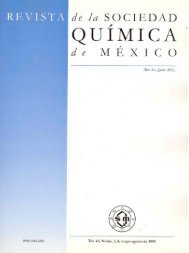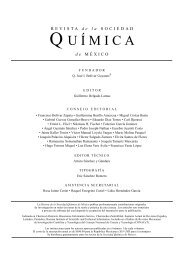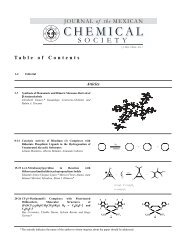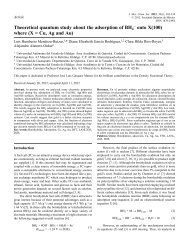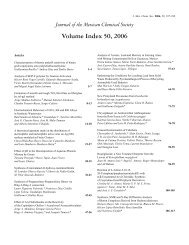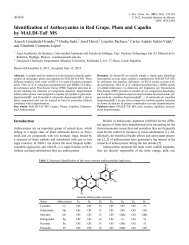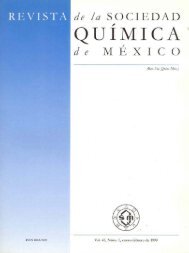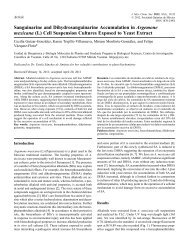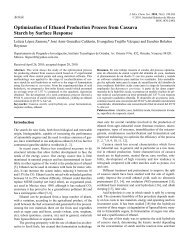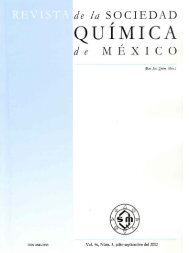SMQ-V047 N-002_ligas_size.pdf - Journal of the Mexican Chemical ...
SMQ-V047 N-002_ligas_size.pdf - Journal of the Mexican Chemical ...
SMQ-V047 N-002_ligas_size.pdf - Journal of the Mexican Chemical ...
Create successful ePaper yourself
Turn your PDF publications into a flip-book with our unique Google optimized e-Paper software.
170 Rev. Soc. Quím. Méx. Vol. 47, Núm. 2 (2003) Rosalba Argumedo Delira et al.<br />
Table 2. Anti-inflammatory activities <strong>of</strong> some extracts <strong>of</strong> S. mexicana<br />
L. var. minor.<br />
Extracts Edema Inhibition (%)<br />
(mg, average SE)<br />
Control (methanol) 15.47 ± 0.32 —<br />
Hexane (flowers) 4.77 ± 0.50 69.17*<br />
Acetone (flowers) 5.60 ± 0.91 63.79*<br />
Methanol (flowers) 13.70 ± 0.31 11.42<br />
Methanol (leaves) 13.10 ± 1.07 15.0<br />
Indomethacin<br />
(positive control) 1.07 ± 0.03 91.35*<br />
All <strong>the</strong> extracts were tested at 1 mg / ear doses. The results were analyzed by<br />
ANOVA. Statistical comparison were made between control group and <strong>the</strong><br />
experimental groups using a t student test. *p < 0.01<br />
13-14, eluted with hexane-EtOAc, 1:1), F5 (fractions 15-19,<br />
eluted with hexane-EtOAc, 3:7) and F6 (fractions 20-22, eluted<br />
with EtOAc). β-sitosterol (1; 686 mg) was isolated from<br />
F3-F6 pools.<br />
Chromatography <strong>of</strong> acetone extract <strong>of</strong> leaves. From <strong>the</strong><br />
acetone extract <strong>of</strong> <strong>the</strong> leaves a total <strong>of</strong> 33 fractions <strong>of</strong> 200 mL<br />
each, were collected. Fractions showing similar TLC data<br />
were combined, affording nine pools (F1-F9): F3 (fractions 8-<br />
10, eluted with hexane-EtOAc, 7:3), F4 (fractions 11-15, eluted<br />
with hexane-EtOAc, 1:1), F5 (fractions 16-18, eluted with<br />
hexane-EtOAc, 3:7), F6 (fractions 19-21, eluted with EtOAc),<br />
F7 (fractions 22-25, eluted with EtOAc-MeOH, 7:3), F8 (fractions<br />
26-29, eluted with EtOAc-MeOH, 1:1) and F9 (fractions<br />
30-33, eluted with MeOH). Ursolic acid (3; 4.210 g; 14.35%)<br />
was isolated from F3-F5 pools and arbutin (4; 2.103 g;<br />
7.168%) was isolated from F5-F8 pools.<br />
Chromatography <strong>of</strong> MeOH extract <strong>of</strong> leaves. The MeOH<br />
extract was partitioned between n-butanol and CH 2 Cl 2 . It<br />
afforded <strong>the</strong> n-butanol extract (46.16 g), which was chromatographed<br />
yielding a total <strong>of</strong> 22 fractions <strong>of</strong> 200 mL each.<br />
Fractions showing similar TLC data were combined, affording<br />
nine pools (F1-F9): F6 (fractions 9-13, eluted with EtOAc-<br />
MeOH, 9:1), F7 (fractions 14-15, eluted with EtOAc-MeOH,<br />
7:3), F8 (fractions 16-18, eluted with EtOAc-MeOH, 1:1) and<br />
F9 (fractions 19-22, eluted with MeOH). Arbutin (4; 5.103 g,<br />
4.3 %) was isolated from F6-F9 pools.<br />
Ursolic acid methyl ester (6). A solution <strong>of</strong> ursolic acid (1 g,<br />
2.19 mmol) in a mixture <strong>of</strong> e<strong>the</strong>r / MeOH (50 mL) was cooled<br />
down to 0 °C in an ice-bath. E<strong>the</strong>real diazomethane was added<br />
until permanent yellow color was obtained. After 24 h <strong>the</strong> solvent<br />
was removed by distillation under low pressure to give<br />
ursol-28-oic acid methyl ester (6; 758 mg; 1.61 mmol; 73.5 %<br />
yield).<br />
3-oxo-urs-28-oic acid methyl ester (7). To a solution <strong>of</strong> 6<br />
(750 mg, 1.6 mmol) in acetone (10 ml) was added an excess<br />
<strong>of</strong> Jones's reagent at 0 °C while stirring. The reaction course<br />
was followed by TLC. After 55 min, <strong>the</strong> excess <strong>of</strong> Jones's<br />
was destroyed by addition <strong>of</strong> MeOH, and <strong>the</strong>n <strong>the</strong> reaction<br />
mixture was diluted with H 2 O (30 mL). Extraction with<br />
CH 2 Cl 2 (4 × 10 mL), drying (Na 2 SO 4 ), filtration and evaporation<br />
<strong>of</strong> <strong>the</strong> solvent gave a residue, which by crystallization<br />
from hexane-EtOAc afforded 7 (321 mg; 0.7 mmol; 43.7 %<br />
yield). Mp 182-184°C, IR (KBr) ν max : 2935, 2867, 1726,<br />
1695, 1459, 1380 and 1142 cm –1 . EIMS 70eV m/z: 468 (M + ,<br />
C 31 H 48 O 3 ), 453, 419, 407, 262, 249, 203 and 189. 1 H NMR<br />
200 MHz CDCl 3 δ: 5.27 (1H, m, H-12), 3.61 (3H, s, OMe),<br />
2.60 (1H, d, H-18), 2.25 (2H, m, H-2), 1.08 (3H, s), 1.04 (6H,<br />
s), 1.06 (3H, d, J=8 Hz), 0.95 (3H, s), 0.85 (3H, d, J=7Hz),<br />
0.79 (3H, s).<br />
2- Formyl-3-oxo-urs-28-oic acid methyl ester (8). To a solution<br />
<strong>of</strong> 0.7 mmol <strong>of</strong> 7 in 7 mL <strong>of</strong> dry pyridine, held under<br />
nitrogen, was added 1.5 mL (18.7 mmol) <strong>of</strong> ethyl formate<br />
(distilled from phosphorus pentoxide) followed by 1 mL <strong>of</strong> a<br />
solution <strong>of</strong> 294 mg (13.3 mmol) <strong>of</strong> sodium in 6 mL <strong>of</strong><br />
absolute methyl alcohol. The resulting solution was <strong>the</strong>n kept<br />
at room temperature under nitrogen overnight. The reaction<br />
was evidenced by <strong>the</strong> appearance <strong>of</strong> a deep color and / or <strong>the</strong><br />
formation <strong>of</strong> an insoluble precipitate. The mixture was poured<br />
into a cold solution <strong>of</strong> 16 mL <strong>of</strong> glacial acetic acid in 150 mL<br />
<strong>of</strong> water, and <strong>the</strong> resulting precipitate was extracted with<br />
CH 2 Cl 2 . The organic layer was washed with water and <strong>the</strong>n<br />
extracted with 3 × 100 mL <strong>of</strong> 2 % potassium hydroxide solution.<br />
The combined basic extract were washed with e<strong>the</strong>r and<br />
acidified with 10 mL <strong>of</strong> glacial acetic acid. Extraction <strong>of</strong> <strong>the</strong><br />
aqueous layer with CH 2 Cl 2 in <strong>the</strong> usual manner, afforded 2-<br />
formyl-3-oxo-urs-28-oic methyl ester (8; 226 mg; 0.46 mmol;<br />
70 % yield).<br />
Reddish viscous liq. IR (CHCl 3 ) ν max : 2925, 2869, 1725,<br />
1636, 1587, 1455, 1360 and 1147 cm –1 . EIMS 70eV m/z: 496<br />
(M + , C 32 H 48 O 4 ), 481, 478, 437, 421, 262, 249, 233, 203 and<br />
189. 1 H NMR 200 MHz CDCl 3 δ: 14.91 (1H, s, OH chelated),<br />
8.57 (1H, s, H-23), 5.29 (1H, m, H-12), 3.61 (3H, s, OMe),<br />
2.32 (1H, d, H-18), 1.25, 1.19, 1.11, 1.09, 0.8 (3H, s, each),<br />
0.93 (3H, d, J=8 Hz), 0.86 (3H, d, J=7Hz).<br />
Table 3. Free radical scavenging activities <strong>of</strong> 8 and 9.<br />
Compound Concentration Reduction<br />
(ppm) <strong>of</strong> DPPH (%)<br />
2- Formyl-3-oxo- 10 12.69*<br />
urs-28-oic acid 100 40.87*<br />
methyl ester (8) 1000 79.43*<br />
2- Formyl-3-oxo- 10 N. A.<br />
urs-1-en-28-oic 100 N. A.<br />
acid methyl ester (9) 1000 N. A.<br />
The results were analyzed by ANOVA. Statistical comparison were made<br />
between control group and <strong>the</strong> experimental groups using a Dunnet’s test. *p<br />
< 0.05, N. A. = Not active.




